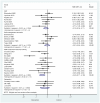The effect of complex interventions on depression and anxiety in chronic obstructive pulmonary disease: systematic review and meta-analysis
- PMID: 23585837
- PMCID: PMC3621386
- DOI: 10.1371/journal.pone.0060532
The effect of complex interventions on depression and anxiety in chronic obstructive pulmonary disease: systematic review and meta-analysis
Abstract
Background: Depression and anxiety are very common in people with chronic obstructive pulmonary disease (COPD) and are associated with excess morbidity and mortality. Patients prefer non-drug treatments and clinical guidelines promote non-pharmacological interventions as first line therapy for depression and anxiety in people with long term conditions. However the comparative effectiveness of psychological and lifestyle interventions among COPD patients is not known. We assessed whether complex psychological and/or lifestyle interventions are effective in reducing symptoms of anxiety and depression in patients with COPD. We then determined what types of psychological and lifestyle interventions are most effective.
Methods and findings: Systematic review of randomised controlled trials of psychological and/or lifestyle interventions for adults with COPD that measured symptoms of depression and/or anxiety. CENTRAL, Medline, Embase, PsychINFO, CINAHL, ISI Web of Science and Scopus were searched up to April 2012. Meta-analyses using random effects models were undertaken to estimate the average effect of interventions on depression and anxiety. Thirty independent comparisons from 29 randomised controlled trials (n = 2063) were included in the meta-analysis. Overall, psychological and/or lifestyle interventions were associated with small reductions in symptoms of depression (standardised mean difference -0.28, 95% confidence interval -0.41 to -0.14) and anxiety (standardised mean difference -0.23, 95% confidence interval -0.38 to -0.09). Multi-component exercise training was the only intervention subgroup associated with significant treatment effects for depression (standardised mean difference -0.47, 95% confidence interval -0.66 to -0.28), and for anxiety (standardised mean difference -0.45, 95% confidence interval -0.71 to -0.18).
Conclusions: Complex psychological and/or lifestyle interventions that include an exercise component significantly improve symptoms of depression and anxiety in people with COPD. Furthermore, multi-component exercise training effectively reduces symptoms of anxiety and depression in all people with COPD regardless of severity of depression or anxiety, highlighting the importance of promoting physical activity in this population.
Conflict of interest statement
Figures













References
-
- Zhang MWB, Ho RCM, Cheung MWL, Fu E, Mak A (2011) Prevalence of depressive symptoms in patients with chronic obstructive pulmonary disease: a systematic review, meta-analysis and meta-regression. Gen Hosp Psychiatry 33: 217–223. - PubMed
-
- Barnes PJ, Celli BR (2009) Systemic manifestations and comorbidities of COPD. Eur Respir J 33: 1165–1185. - PubMed
-
- Hanania NA, Müllerova H, Locantore NW, Vestbo J, Watkins ML, et al., on behalf of the Evaluation of COPD Longitudinally to Identify Predictive Surrogate Endpoints (ECLIPSE) study investigators (2011) Determinants of Depression in the ECLIPSE Chronic Obstructive Pulmonary Disease Cohort. Am J Respir Crit Care Med 183: 604–611. - PubMed
-
- Ng T, Niti M, Wan T, Cao Z, Ong K, Eng P (2007) Depressive symptoms and chronic obstructive pulmonary disease effect on mortality, hospital readmission, symptom burden, functional status, and quality of life. Arch Intern Med 167: 60–67. - PubMed
Publication types
MeSH terms
Grants and funding
LinkOut - more resources
Full Text Sources
Other Literature Sources
Medical
Miscellaneous

